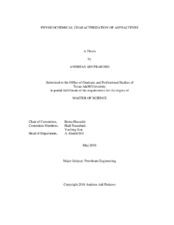| dc.description.abstract | This work proposes the study on physicochemical characterization of crude oils and their asphaltenes to understand the destabilization mechanism of asphaltenes. Knowledge on the molecular-scale interactions between components of crude oil is vital for the assessment of potential reserves and mitigation efforts of asphaltene-related problems. 11 heavy oil and bitumen samples from various regions of the world were subjected to characterization to attain universal yet simple correlations that are applicable under operating conditions. Comprehensive physicochemical analysis of the samples were performed through density and viscosity measurements of the crude oil, Saturates, Aromatics, Resins, and Asphaltenes (SARA) fractionation, Fourier Transform InfraRed (FTIR) spectroscopy analysis, elemental analysis, solubility profile assessment, and onset asphaltene precipitation (OAP) tests on the crude oil samples. Furthermore, two different types of asphaltenes were examined; n-pentane and n-heptane insolubles. Accordingly, density, zeta potential, and cluster size measurements, as well as high resolution microscopy imaging techniques, were conducted on these asphaltene samples to support the asphaltene stability and onset precipitation test results. The results have revealed that heteroatoms contained within the crude oils and asphaltenes play an important role in defining the physicochemical characteristics of crude oil. In particular, oxygen and metal (mostly V and Ni) functional groups were found to contribute significantly towards asphaltene stability and polarity. Additionally, this study has established that the presence of impurities in the saturates fraction causes it to have a destabilizing power towards asphaltenes. Thus, higher concentration of saturate fraction in the crude oil may pose higher risks of asphaltene-related issues. Moreover, it is highly recommendable that OAP experiments are conducted by using the crude oil’s own saturate fraction to achieve better accuracy and provide representative results of actual reservoir conditions. | en |


